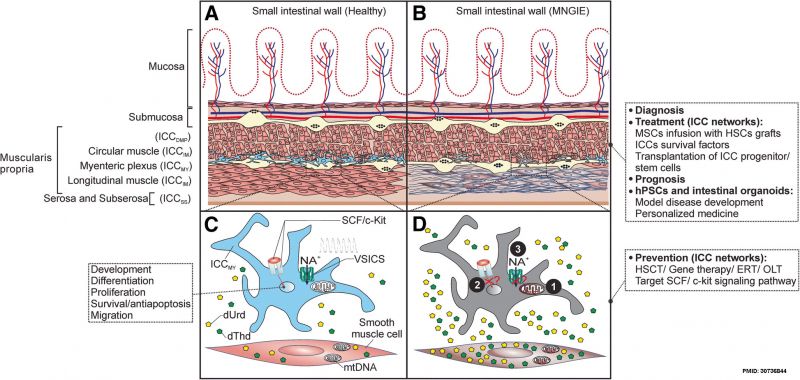File:MNGIE and altered ICC 01.jpg

Original file (1,946 × 925 pixels, file size: 434 KB, MIME type: image/jpeg)
Mitochondrial neurogastrointestinal encephalomyopathy and Interstitial Cells of Cajal
Mitochondrial neurogastrointestinal encephalomyopathy - (MNGIE) is a rare metabolic disease.
Interstitial Cells of Cajal - (ICC) a family of gastrointestinal neurons with different functions.
Pathogenesis of altered ICC networks in MNGIE, prevention and treatment prospects.
A - Representation of the anatomical localization of the subtypes of interstitial cells of Cajal (ICC) in the human small intestine (SI). The specific types of ICC are indicated in parenthesis. Depicted are the ICCMY (blue), prominent and associated with the ganglia of the myenteric plexus region. ICCMY are the primary pacemaker cells in the small intestine, responsible for generation and propagation of electrical slow waves and are rich with mitochondria.
B - ICC/ ICC networks are compromised in MNGIE. ICC/ ICC networks are disturbed and ICCMY are depleted in MNGIE patients. Dysfunction of ICC networks is thought to precede the myo/ neurogenic morphological changes [31], mainly atrophy and fibrosis of the longitudinal muscle external layer of muscularis propria (depicted). Additionally to typical symptoms and biochemical parameters, at this stage, gastrointestinal biopsies could serve to confirm diagnose of MNGIE as well as to evaluate the status of ICC networks prior to treatment to predict the therapeutic outcome on GI manifestations and monitor the impact of treatment on the restoration of ICC networks (prognosis). This is made feasible by routine histology of the gastrointestinal biopsies [24].
C and D - Proposed molecular mechanisms responsible for impaired ICC networks in MNGIE.
C - SCF/c-Kit signaling pathway is necessary for development, proliferation, maintenance of ICC/ ICC function, and voltage-sensitive ion channels (VSICs) are necessary for generation and propagation of electrical slow waves and motor activity of ICC.
D - In MNGIE, however, loss of ICC/ICC networks and dysfunctional ICC might be a secondary event due to altered thymidine (dThd) and deoxyuridine (dUrd) levels that leads to (1) mitochondrial DNA (mtDNA) instability, mitochondrial energy failure, interference with mitochondrial-mediated Ca2+ cycling and cells death (mtDNA depletion is also reported in the smooth muscle cells of the longitudinal muscle external layer of muscularis propria). In addition, unbalanced nucleosides might attribute to (2) Blocking of SCF/c-Kit signaling, which hinders the development, proliferation and maintenance of function of ICC networks, probably by transdifferentiation of ICCMY into a smooth muscle cell-like phenotype or cell death, and probably to (3) Disturbance of the VSICs such as Ano1 or Nav1.5, which impairs generation and propagation of electrical slow waves, SI contractions and motility, or (4) the homing capacity of the BM-derived ICC to the small intestine might be compromised (not shown). Multiple mechanisms might act together. Prevention interventions are applied to cease further deterioration of the ICC/ ICC networks, therefore preferably applied at earlier stages of the disease progression.
Treatment interventions focus on restoration of damaged ICC networks. Infusion of MSCs along with HSCT not only promotes homing, survival and quiescence of HSCs but also could replenish the ICC pool in the small intestine by differentiation into ICC and homing to SI. Novel technologies to improve the homing capacity of MSCs and promote their engraftment in the SI could involve enhanced ex vivo cell culture conditions, gene modifications or coating with antibodies into cell surface. Additionally, administration of candidate survival factors of residual ICC stem/ progenitor cells would replenish remaining ICC pools. ICC stem/ progenitor cells can be selected via cell surface markers for transplantation, alternatively, human pluripotent stem cells (hPSCs) would advance our knowledge about- and provide an accessible source of ICC. Healthy and MNGIE patients- derived organoids are expected to accurately model GI dysmotility development and prevention and eventually be applied clinically in personalized and regenerative medicine.
{from original figure legend)
Reference
Yadak R, Breur M & Bugiani M. (2019). Gastrointestinal Dysmotility in MNGIE: from thymidine phosphorylase enzyme deficiency to altered interstitial cells of Cajal. Orphanet J Rare Dis , 14, 33. PMID: 30736844 DOI.
Copyright
Open Access This article is distributed under the terms of the Creative Commons Attribution 4.0 International License (http://creativecommons.org/licenses/by/4.0/), which permits unrestricted use, distribution, and reproduction in any medium, provided you give appropriate credit to the original author(s) and the source, provide a link to the Creative Commons license, and indicate if changes were made. The Creative Commons Public Domain Dedication waiver (http://creativecommons.org/publicdomain/zero/1.0/) applies to the data made available in this article, unless otherwise stated.
Cite this page: Hill, M.A. (2024, April 26) Embryology MNGIE and altered ICC 01.jpg. Retrieved from https://embryology.med.unsw.edu.au/embryology/index.php/File:MNGIE_and_altered_ICC_01.jpg
- © Dr Mark Hill 2024, UNSW Embryology ISBN: 978 0 7334 2609 4 - UNSW CRICOS Provider Code No. 00098G
File history
Click on a date/time to view the file as it appeared at that time.
| Date/Time | Thumbnail | Dimensions | User | Comment | |
|---|---|---|---|---|---|
| current | 12:18, 11 March 2019 |  | 1,946 × 925 (434 KB) | Z8600021 (talk | contribs) | Mitochondrial neurogastrointestinal encephalomyopathy (MNGIE) is a rare metabolic disease. Pathogenesis of altered ICC networks in MNGIE, prevention and treatment prospects. a Representation of the anatomical localization of the subtypes of interstit... |
You cannot overwrite this file.
File usage
There are no pages that use this file.